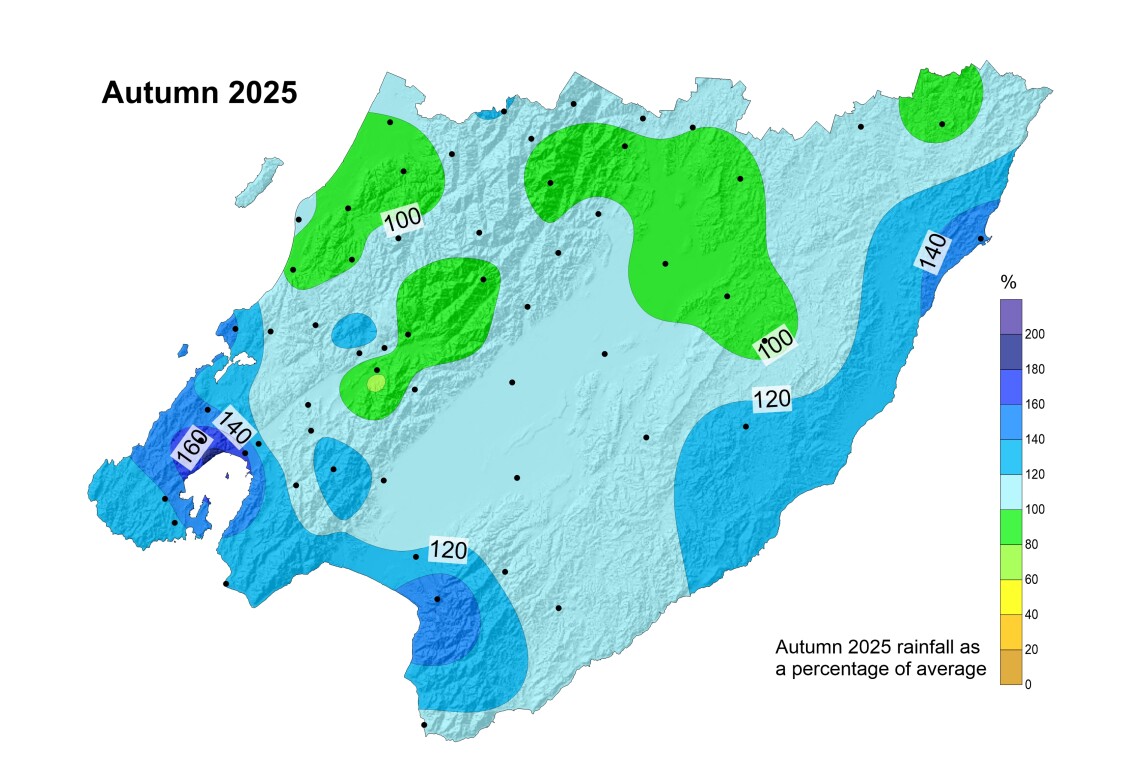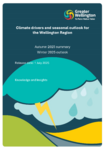A brief summary of climate and hydrological conditions in the region.
This service is regularly updated during periods in which closer monitoring is required (regardless of time of the year), in recognition that there is potential for dry spells, or irregular hydrological recharging. It does not define an official council position on drought or drought declaration. Outside of dry periods, less frequent updates synchronise with our latest seasonal outlooks.
Updated 2 July 2025
Next update due when there is a significant change of conditions or a new seasonal outlook.
Background
Autumn has brought significant rainfall to most of the region, which continued into the first month of winter. Wellington, the south coast and the eastern Wairarapa coast were the key ‘hotspots’, with certain areas receiving a total accumulation more than 50% greater than the long-term seasonal average. Even though La Niña has been over for a while, the lingering effects of a blocking anticyclone east of New Zealand with some intermittent easterly flow, and atmospheric rivers with subtropical influences, have largely kept the rainfall above normal levels.

Current situation
Soil moisture levels have returned to mostly above average, benefiting from the replenishing seasonal accumulations over a good part of the Wairarapa. At the same time, the rainfall over the main ranges has been mostly average, with less downstream impacts on the main catchments and river levels.
Meteorological outlook
International climate models are predicting that the atmosphere will continue to be influenced by an intermittent easterly flow and occasional subtropical influences (e.g. atmospheric rivers). Thanks to prevailing anticyclones, a regular frost pattern is expected during the first half of the season. As the cold season progresses, rainfall is expected to sit more around normal levels for the Wairarapa, and normal to above normal west of the main ranges. ENSO is expected to remain neutral for at least until the end of the year.
Climate change
The ‘normal’ longer-term water balance is becoming increasingly hard to maintain quite possibly due to climate change influences, and increased high frequency climate variability, with more unreliable weather patterns. Droughts are expected to become more severe and frequent in the Wellington region, particularly in the Wairarapa. Even if international climate policy efforts were to successfully contain global warming under 1.5-2 degrees (the Paris Agreement’s ambition), it is important that we enhance our water resilience and be prepared for more unreliable climate patterns with both extreme dry and extreme wet periods. We note that the warming of the land also means that evapotranspiration will greatly increase, so the soil will likely need more ongoing rain to maintain ideal moisture levels, compared to what it has needed in the past.
View the latest national drought index state
View the national drought forecasting dashboard
View the latest seasonal report:
Climate drivers and seasonal outlook for the Wellington Region - Autumn 2025 summary Winter 2025 outlook


date_range Published 02 Jul 2025
Download now (PDF 1.7 MB) get_appBrowse the data
Anomaly Maps
How different has recent rainfall/soil moisture been compared with the same time in previous years?
Site-specific graphs
| Area | Rainfall | Soil Moisture |
| Kapiti Coast (lowland) | Otaki at Depot | |
| Kapiti Coast (high altitude) | Penn Creek at McIntosh | |
| Porirua | Horokiri Stream at Battle Hill | |
| Wellington City | Kaiwharawhara Stream at Karori Reservoir | |
| Hutt Valley (upper catchment) | Hutt River at Kaitoke Headworks | |
| Upper Hutt | Upper Hutt at Savage Park | Upper Hutt at Savage Park AQ |
| Wainuiomata | Wanuiomata River at Wainui Reservoir | |
| Wairarapa (high altitude) | Waingawa River at Angle Knob | |
| Wairarapa Valley (north) | Kopuaranga River at Mauriceville | |
| Wairarapa Valley (Masterton) | Ruamahanga River at Wairarapa College | Wairarapa College AQ |
| Wairarapa Valley (south) | Tauherenikau River at Racecourse | Tauherenikau River at Racecourse |
| Wairarapa (north-eastern hills) | Whareama River at Tanawa Hut | Whareama River at Tanawa Hut |
| Wairarapa (south-eastern hills) | Waikoukou at Longbush | Waikoukou at Longbush |
Get in touch
- Phone:
- 0800496734
- Email:
- info@gw.govt.nz
